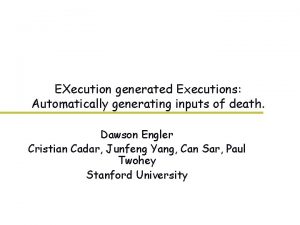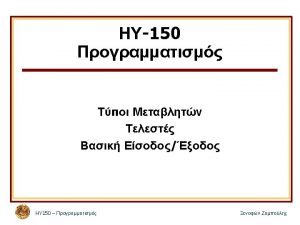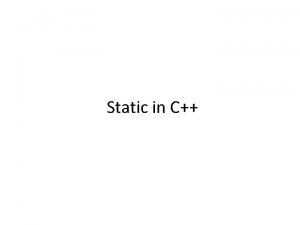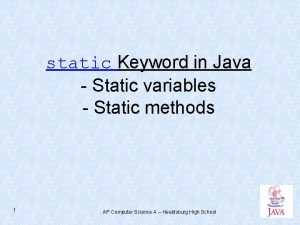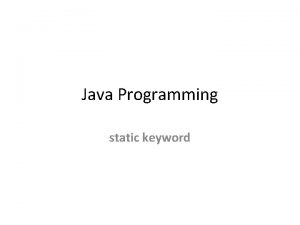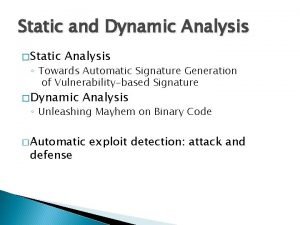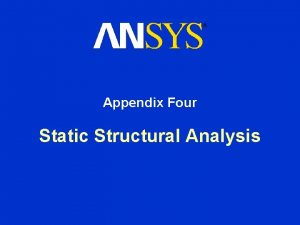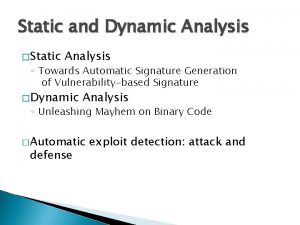A Static Analysis Approach for Automatically Generating Test
















- Slides: 16

A Static Analysis Approach for Automatically Generating Test Cases for Web Applications Presented by: Beverly Leung Fahim Rahman 1

Introduction to Web Applications • Web applications are: – interactive systems which run on one or more web servers – dynamic in behavior (customized responses for the user and interact with databases and/or enterprise servers) – heterogeneous in representation – used by businesses in a variety of major market areas (information management, online banking and shopping) *Source: Halfond, W et al. “Improving Test Case Generation for Web Applications Using Automated Interface Discovery” • As a result, thorough testing of web • applications is becoming increasingly important Testing methodologies that are used for traditional software testing are insufficient 2

Static Analysis Approach to Testing • Analyze source code without execution • Extract interfaces which include – input parameters and domain information – User navigation map which has all possible URLs from source code • Create navigation graph – set of paths for which test cases are generated 3

Example – Student Information Management System (SIMS) • An application that can support data associated with a college class • Three views with different services: – Administrator – Professor – Student 4

Example – SIMS • Login page asks for ID, password, user type – Source code validates for proper input parameters – If invalid, error handling message • Illustrates how web apps have a need for specific parameter types in order to properly test 5

Example – SIMS Login Code Fragment 1 <jsp: use. Bean id="test" scope="session" class="Test. Bean"/> 2 <% 3 int user_id = Interger. parse. Int(request. get. Parameter("user. Id")); 4 String password = request. get. Parameter("user. Passwd"); 5 String user_type = request. get. Parameter("user. Type"); 6 boolean ispass= test. verify(user_id, user_type, password); 7 if (ispass) { 8 if(user_type. equals(“student”)){ 9 %> 10 Student: <jsp: get. Property name="test" property="user. Name"/> 11 login success! 12 <a href="student_first_page. jsp">Click here to continue</a> 13 <% } 14 else if(user_type. equals(“professor”)){ 15 %> 16 Professor: <jsp: get. Property name="test" property="user. Name"/> 17 login success! 18 <a href="professor_first_page. jsp">Click here to continue</a> 19 <% } 20 else{ 21 %> 22 Administrator: <jsp: get. Property name="test" property="user. Name"/> 23 login success! 24 <a href="administrator_first_page. jsp">Click here to continue</a> 25 <% } 26 } 27 else { 28 %> 29 <jsp: forward page="error. jsp" flush="true"></jsp: forward> 30 <%} 31 %> 6

Example – SIMS Definitions • Control Flow Graph of a page – G = (V, E) where G is a directed graph, V are nodes and E are edges connecting the nodes. – node = one statement – edge = possible flow of control between two statements 7

Example – SIMS Definitions • x, y are nodes and x ≠ y • Post dominate – x “post dominates” y if every path from y to exit node contains x • Control dependent – x is “control dependent” on y … – if there exists y 1 and y 2 as successors of y – x post dominates y 1 but not y 2 8

Example – SIMS Definitions • Transition node (t-node) = node in the CFG • • which may lead to a transition from one page to another Transition path (t-path) = a path which starts from the begin node and ends at a t-node Transition Flow Graph = set of nodes and edges which show dependency, usage, and definition of parameters 9

Example – SIMS Sample Transition Flow Graph for the login page 10

Example – SIMS Static Analysis Approach • Identify all T-nodes • T-paths are identified using Depth First Search • Loops that are executed n times should be • • analyzed n times. If number of executions depends on variable, traverse loop only once T-paths are then executed as part of the control flow graph. Irrelevant paths are eliminated using a path slicing technique which is based on whether or not a target node can be reached 11

Example – SIMS Static Analysis Approach • Automated interface discovery algorithm is used to extract input parameter and domain information through analyzed source code • Each path slice is “symbolically executed” which uses symbolic values and input variables as opposed to concrete values 12

Example – SIMS Web Navigation Graph • constructed from source code as a directed graph where vertices = webpages and directed edges = transition between pages • May include input parameters and path conditions associated with transition • Paths from this graph can be used as a basis for test scenarios 13

Example – SIMS Generating Test Cases • Web Navigation Graph and Interfaces are used to generate test cases • Test Case = a path through the web navigation graph that has input values which satisfy path conditions • These input values are chosen based on the domain information found using the automated interface discovery algorithm 14

Conclusions • The static approach benefits automatic generation of test cases by providing: – more accurate interfaces of web application – More appropriate input parameter values for web forms – Better targeting by using domain information of input parameters to provide appropriate or inappropriate parameter values 15

References • Minghui Wang et al. “A Static Analysis Approach for Automatic • • Generating Test Cases for Web Applications, ” 2008 International Conference on Computer Science and Software Engineering William G. J. Halfond and Alessandro Orso, “Improving test case generation for Web applications using automated interface discovery”, ESEC/FSE’ 07 Sep. 3 -7, 2007, pp. 145 -154 Bin Zhu et al. “Testing a Web Application Involving Web Browser Interaction, ” 2009 10 th ACIS International Conference on Software Engineering, Artificial Intelligences, Networking and Parallel/Distributed Computing 16
 Exe: automatically generating inputs of death
Exe: automatically generating inputs of death Exe: automatically generating inputs of death
Exe: automatically generating inputs of death Clint whaley
Clint whaley Static malware analysis vs dynamic malware analysis
Static malware analysis vs dynamic malware analysis Fspos vägledning för kontinuitetshantering
Fspos vägledning för kontinuitetshantering Novell typiska drag
Novell typiska drag Nationell inriktning för artificiell intelligens
Nationell inriktning för artificiell intelligens Returpilarna
Returpilarna Varför kallas perioden 1918-1939 för mellankrigstiden?
Varför kallas perioden 1918-1939 för mellankrigstiden? En lathund för arbete med kontinuitetshantering
En lathund för arbete med kontinuitetshantering Särskild löneskatt för pensionskostnader
Särskild löneskatt för pensionskostnader Vilotidsbok
Vilotidsbok A gastrica
A gastrica Densitet vatten
Densitet vatten Datorkunskap för nybörjare
Datorkunskap för nybörjare Boverket ka
Boverket ka Hur skriver man en debattartikel
Hur skriver man en debattartikel
